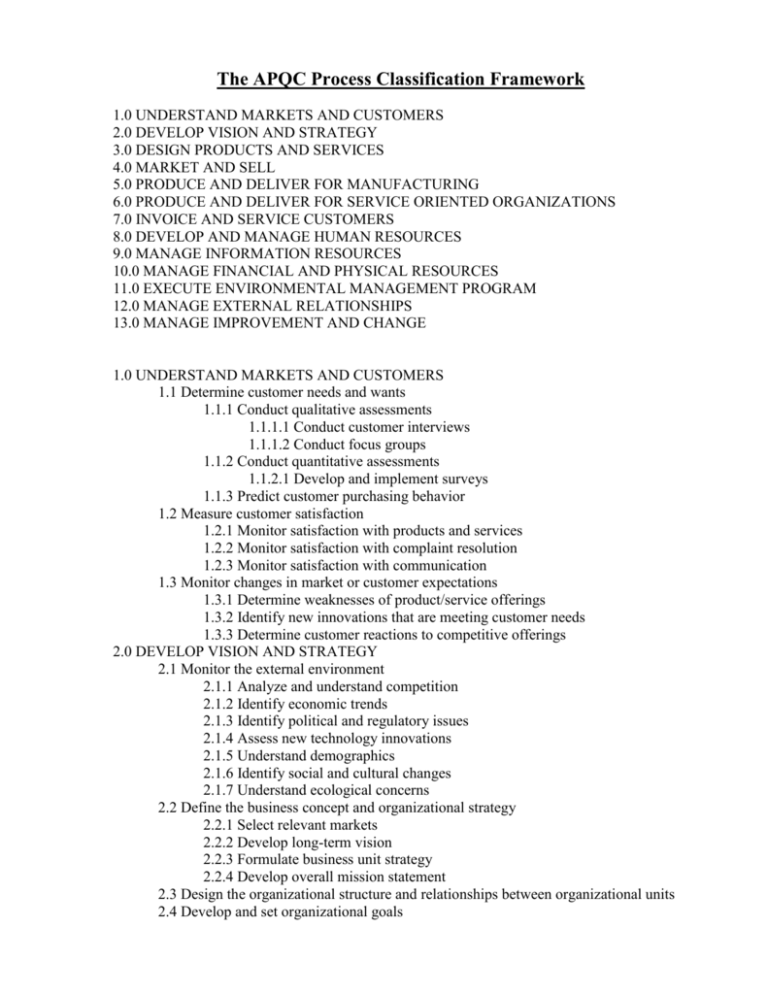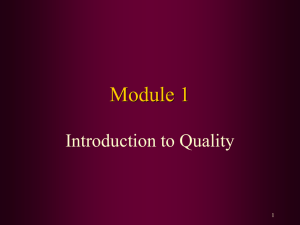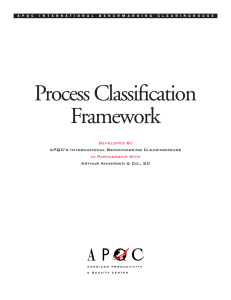The APQC Process Classification Framework
advertisement

The APQC Process Classification Framework 1.0 UNDERSTAND MARKETS AND CUSTOMERS 2.0 DEVELOP VISION AND STRATEGY 3.0 DESIGN PRODUCTS AND SERVICES 4.0 MARKET AND SELL 5.0 PRODUCE AND DELIVER FOR MANUFACTURING 6.0 PRODUCE AND DELIVER FOR SERVICE ORIENTED ORGANIZATIONS 7.0 INVOICE AND SERVICE CUSTOMERS 8.0 DEVELOP AND MANAGE HUMAN RESOURCES 9.0 MANAGE INFORMATION RESOURCES 10.0 MANAGE FINANCIAL AND PHYSICAL RESOURCES 11.0 EXECUTE ENVIRONMENTAL MANAGEMENT PROGRAM 12.0 MANAGE EXTERNAL RELATIONSHIPS 13.0 MANAGE IMPROVEMENT AND CHANGE 1.0 UNDERSTAND MARKETS AND CUSTOMERS 1.1 Determine customer needs and wants 1.1.1 Conduct qualitative assessments 1.1.1.1 Conduct customer interviews 1.1.1.2 Conduct focus groups 1.1.2 Conduct quantitative assessments 1.1.2.1 Develop and implement surveys 1.1.3 Predict customer purchasing behavior 1.2 Measure customer satisfaction 1.2.1 Monitor satisfaction with products and services 1.2.2 Monitor satisfaction with complaint resolution 1.2.3 Monitor satisfaction with communication 1.3 Monitor changes in market or customer expectations 1.3.1 Determine weaknesses of product/service offerings 1.3.2 Identify new innovations that are meeting customer needs 1.3.3 Determine customer reactions to competitive offerings 2.0 DEVELOP VISION AND STRATEGY 2.1 Monitor the external environment 2.1.1 Analyze and understand competition 2.1.2 Identify economic trends 2.1.3 Identify political and regulatory issues 2.1.4 Assess new technology innovations 2.1.5 Understand demographics 2.1.6 Identify social and cultural changes 2.1.7 Understand ecological concerns 2.2 Define the business concept and organizational strategy 2.2.1 Select relevant markets 2.2.2 Develop long-term vision 2.2.3 Formulate business unit strategy 2.2.4 Develop overall mission statement 2.3 Design the organizational structure and relationships between organizational units 2.4 Develop and set organizational goals 3.0 DESIGN PRODUCTS AND SERVICES 3.1 Develop new product/service concept and plans 3.1.1 Translate customer wants and needs into product and/or service requirements 3.1.2 Plan and deploy quality targets 3.1.3 Plan and deploy cost targets 3.1.4 Develop product life cycle and development timing targets 3.1.5 Develop and integrate leading technology into product/service concept 3.2 Design, build, and evaluate prototype products and services 3.2.1 Develop product/service specifications 3.2.2 Conduct concurrent engineering 3.2.3 Implement value engineering 3.2.4 Document design specifications 3.2.5 Develop prototypes 3.2.6 Apply for patents 3.3 Refine existing products/services 3.3.1 Develop product/service enhancements 3.3.2 Eliminate quality/reliability problems 3.3.3 Eliminate outdated products/services 3.4 Test effectiveness of new or revised products or services 3.5 Prepare for production 3.5.1 Develop and test prototype production process 3.5.2 Design and obtain necessary materials and equipment 3.5.3 Install and verify process or methodology 3.6 Manage the product/service development process 4.0 MARKET AND SELL 4.1 Market products or services to relevant customer segments 4.1.1 Develop pricing strategy 4.1.2 Develop advertising strategy 4.1.3 Develop marketing messages to communicate benefits 4.1.4 Estimate advertising resource and capital requirements 4.1.5 Identify specific target customers and their needs 4.1.7 Sell products and services 4.1.8 Negotiate terms 4.2 Process customer orders 4.2.1 Accept orders from customers 4.2.2 Enter orders into production and delivery process 5.0 PRODUCE AND DELIVER FOR MANUFACTURING 5.1 Plan for and acquire necessary resources 5.1.1 Select and certify suppliers 5.1.2 Purchase capital goods 5.1.3 Purchase materials and supplies 5.1.4 Acquire appropriate technology 5.2 Convert resources or inputs into products 5.2.1 Develop and adjust production delivery process (for existing process) 5.2.2 Schedule production 5.2.3 Move materials and resources 5.2.4 Make product 5.2.5 Package product 5.2.6 Warehouse or store product 5.2.7 Stage products for delivery 5.3 Deliver products 5.3.1 Arrange product shipment 5.3.2 Deliver products to customers 5.3.3 Install product 5.3.4 Confirm specific service requirements for individual customers 5.3.5 Identify and schedule resources to meet service requirements 5.3.6 Provide the service to specific customers 5.4 Manage production and delivery process 5.4.1 Document and monitor order status 5.4.2 Manage inventories 5.4.3 Assure product quality 5.4.4 Schedule and perform maintenance 5.4.5 Monitor environmental constraints 6.0 PRODUCE AND DELIVER FOR SERVICE ORIENTED ORGANIZATIONS 6.1 Plan for and acquire necessary resources 6.1.1 Select and certify suppliers 6.1.2 Purchase materials and supplies 6.1.3 Acquire appropriate technology 6.2 Develop human resource skills 6.2.1 Define skill requirements 6.2.2 Identify and implement training 6.2.3 Monitor and manage skill development 6.3 Deliver service to the customer 6.3.1 Confirm specific service requirements for individual customer 6.3.2 Identify and schedule resources to meet service requirements 6.3.3 Provide the service to specific customers 6.4 Ensure quality of service 7.0 INVOICE AND SERVICE CUSTOMERS 7.1 Bill the customer 7.1.1 Develop, deliver, and maintain customer billing 7.1.2 Invoice the customer 7.1.3 Respond to billing inquiries 7.2 Provide after-sales service 7.2.1 Provide post-sales service 7.2.2 Handle warranties and claims 7.3 Respond to customer inquiries 7.3.1 Respond to information requests 7.3.2 Manage customer complaints 8.0 DEVELOP AND MANAGE HUMAN RESOURCES 8.1 Create and manage human resource strategies 8.1.1 Identify organizational strategic demands 8.1.2 Determine human resource costs 8.1.3 Define human resource requirements 8.1.4 Define human resource's organizational role 8.2 Cascade strategy to work level 8.2.1 Analyze, design, or redesign work 8.2.3 Define work competencies 8.3 Manage deployment of personnel 8.3.1 Plan and forecast workforce requirements 8.3.2 Develop succession and career plans 8.3.3 Recruit, select, and hire employees 8.3.4 Create and deploy teams 8.3.5 Relocate employees 8.3.6 Restructure and rightsize workforce 8.3.7 Manage employee retirement 8.3.8 Provide outplacement support 8.4 Develop and train employees 8.4.1 Align employee and organizational development needs 8.4.2 Develop and manage training programs 8.4.3 Develop and manage employee orientation programs 8.4.4 Develop functional/process competencies 8.4.5 Develop management/leadership competencies 8.4.6 Develop team competencies 8.5 Manage employee performance, reward, and recognition 8.5.1 Define performance measures 8.5.2 Develop performance management approaches and feedback 8.5.3 Manage team performance 8.5.4 Evaluate work for market value and internal equity 8.5.5 Develop and manage base and variable compensation 8.5.6 Manage reward and recognition programs 8.6 Ensure employee well-being and satisfaction 8.6.1 Manage employee satisfaction 8.6.2 Develop work and family support systems 8.6.3 Manage and administer employee benefits 8.6.4 Manage workplace health and safety 8.6.5 Manage internal communications 8.6.6 Manage and support workforce diversity 8.7 Ensure employee involvement 8.8 Manage labor-management relationships 8.8.1 Manage collective bargaining process 8.9 Develop Human Resource Information Systems (HRIS) 9.0 MANAGE INFORMATION RESOURCES 9.1 Plan for information resource management 9.1.1 Derive requirements from business strategies 9.1.2 Define enterprise system architectures 9.1.3 Plan and forecast information technologies & methodologies 9.1.4 Establish enterprise data standards 9.1.5 Establish quality standards and controls 9.2 Develop and deploy enterprise support systems 9.2.1 Conduct specific needs assessments 9.2.2 Select information technologies 9.2.3 Define data life cycles 9.2.4 Develop enterprise support systems 9.2.5 Test, evaluate, and deploy enterprise support systems 9.3 Implement systems security and controls 9.3.1 Establish systems security strategies and levels 9.3.2 Test, evaluate, and deploy systems security and controls 9.4 Manage information storage & retrieval 9.4.1 Establish information repositories (databases) 9.4.2 Acquire and collect information 9.4.3 Store information 9.4.4 Modify and update information 9.4.5 Enable retrieval of information 9.4.6 Delete information 9.5 Manage facilities and network operations 9.5.1 Manage centralized facilities 9.5.2 Manage distributed facilities 9.5.3 Manage network operations 9.6 Manage information services 9.6.1 Manage libraries and information centers 9.6.2 Manage business records and documents 9.7 Facilitate information sharing and communication 9.7.1 Manage external communications systems 9.7.3 Prepare and distribute publications 9.8 Evaluate and audit information quality 10.0 MANAGE FINANCIAL AND PHYSICAL RESOURCES 10.1 Manage financial resources 10.1.1 Develop budgets 10.1.2 Manage resource allocation 10.1.3 Design capital structure 10.1.4 Manage cash flow 10.1.5 Manage financial risk 10.2 Process finance and accounting transactions 10.2.1 Process accounts payable 10.2.2 Process payroll 10.2.3 Process accounts receivable, credit, and collections 10.2.4 Close the books 10.2.5 Process benefits and retiree information 10.2.6 Manage travel and entertainment expenses 10.3 Report information 10.3.1 Provide external financial information 10.3.2 Provide internal financial information 10.4 Conduct internal audits 10.5 Manage the tax function 10.5.1 Ensure tax compliance 10.5.2 Plan tax strategy 10.5.3 Employ effective technology 10.5.4 Manage tax controversies 10.5.5 Communicate tax issues to management 10.5.6 Manage tax administration 10.6 Manage physical resources 10.6.1 Manage capital planning 10.6.2 Acquire and redeploy fixed assets 10.6.3 Manage facilities 10.6.4 Manage physical risk 11.0 EXECUTE ENVIRONMENTAL MANAGEMENT PROGRAM 11.1 Formulate environmental management strategy 11.2 Ensure compliance with regulations 11.3 Train and educate employees 11.4 Implement pollution prevention program 11.5 Manage remediation efforts 11.6 Implement emergency response programs 11.7 Manage government agency and public relations 11.8 Manage acquisition/divestiture environmental issues 11.9 Develop and manage environmental information system 11.10 Monitor environmental management program 12.0 MANAGE EXTERNAL RELATIONSHIPS 12.1 Communicate with shareholders 12.2 Manage government relationships 12.3 Build lender relationships 12.4 Develop public relations program 12.5 Interface with board of directors 12.6 Develop community relations 12.7 Manage legal and ethical issues 13.0 MANAGE IMPROVEMENT AND CHANGE 13.1 Measure organizational performance 13.1.1 Create measurement systems 13.1.2 Measure product and service quality 13.1.3 Measure cost of quality 13.1.4 Measure costs 13.1.5 Measure cycle time 13.1.6 Measure productivity 13.2 Conduct quality assessments 13.2.1 Conduct quality assessments based on external criteria 13.2.2 Conduct quality assessments based on internal criteria 13.3 Benchmark performance 13.3.1 Develop benchmarking capabilities 13.3.2 Conduct process benchmarking 13.4 Improve processes and systems 13.4.1 Create commitment for improvement 13.4.2 Implement continuous process improvement 13.4.3 Reengineer business processes and systems 13.4.4 Manage transition to change 13.5 Implement TQM 13.5.1 Create commitment for TQM 13.5.2 Design and implement TQM systems 13.5.3 Manage TQM life cycle





